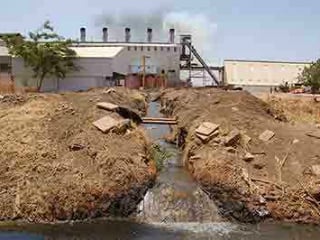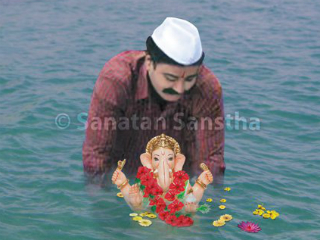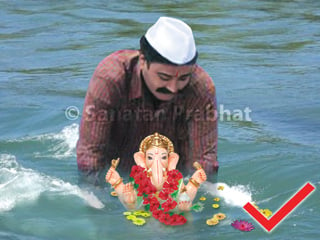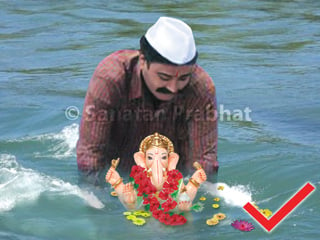
Now that the Ganesh festival is approaching, as usual the self-proclaimed reformers and their organisations who call themselves as environmentalists will start getting active. Some years ago these people had claimed that immersion of Ganesh Idols during the Ganesh festival is resulting in water pollution. Due to lack of education on Dharma and so-called forward-mindedness, several people fell prey to their tactics; however now these self-proclaimed social reformers and social workers are getting exposed. Proclaiming that the dyes used in painting the Idols are water pollutants, a fashion of immersing these Idols in artificial tanks, instead of lakes, rivers or creeks, or handing them over to the self-proclaimed reformers, has commenced.
Ganesh immersion which is going on for thousands of years has not caused environmental loss but within a span of just a century science has destroyed the environment. When devout Hindus allege that anti-Hindus are making a farce of environmental pollution only because they want to stop immersion of Ganesh Idols the anti-Hindus protest saying that the devout Hindus are accusing them falsely and that we are making sincere efforts to curb pollution.
These series of articles are written so that you are able to question members of Andhashraddha Nirmulan Samiti about the causes of pollution given ahead, during their campaigns for celebrating Holi on a small scale and donating sweets instead of offering it into Holi or of donating Ganesh Idols to them instead of immersing them in water.
1. Gang of so-called reformers who turn blind eye to water pollution caused by slaughter houses
1A. Report from the Controller and Auditor General
In the audit report for 2010-11 (financial year ending on March 31, 2011) the Controller and Auditor General while mentioning about the sources of water pollution, had highlighted slaughter houses as one of the sources. The statement goes as follows –
As per the environmental protection Act of 1986 there are norms set for discharge of waste from slaughter houses, with specific directives given to implement them.
Large quantities of water is used in slaughter houses to wash the meat and to clean the area of animal slaughter. In January 2001, the Central Pollution Control Board has prescribed that to maintain the quality of water the water expelled from slaughter houses should be treated appropriately. If the waste water from slaughter houses is discharged without proper treatment, it results in outbreak of disease spreading elements. The waste water also seeps into the ground and pollutes the ground water.
In the six regional offices which were inspected, the report of the auditor revealed that there were 56 slaughter houses operating within their field of action out of which 39 had no permissions whatsoever from the Pollution Control Board. In fact they had not even submitted applications seeking permission to run the slaughter houses. Only in 1 slaughter house in Aurangabad (Sambhajinagar) arrangements were made for an effluent treatment plant. 55 slaughter houses were found to be discharging their sewage without treatment into open drainage system through which it was flowing into nearby water bodies. Regional offices have recorded that Aurangabad Municipal Corportaion, Nasik Municipal Corporation etc. and related organisations were directed in July 2008 to act against the slaughter houses. Thereafter, as per the Water Act 1974 section 33 (A) untill March-April 2011, neither notices for their closure nor for water and electricity disconnection were issued to them. No action had been taken as per clauses 41 to 44 as per Act 1947 for ban and control of water pollution against erring slaughter houses.
All the above points reveal that these self-proclaimed fake reformers failed to notice the environmental damage caused by illegally run slaughter houses in such large numbers. If action is taken against such slaughter houses then the religious sentiments of a certain section of society will get hurt hence they never oppose them. These people who turn blind eye to the massive pollution from slaughter houses suddenly become alert when it comes to Ganesh Idol immersion. These reformists are probably daring to denigrate Ganapati only because Hindu society fails to react with the same aggression as that of the particular community which prevents this group from even thinking about shutting down the slaughter houses.
2. Gang of self-proclaimed reformers who conveniently choose to ignore the pollution of rivers caused by crores of litres of sewage
2A. River Bhima Pollution Control Plan
The Regional office of the Maharashtra Pollution Control Board published the River Bhima Pollution Control Plan 2010. 127 water plans associated with water pollution have given the following points which need to be pondered upon seriously.
2A 1. Several large cities and villages in Pune District are situated on the banks of this river. These city housing complexes release the sewage treated only fractionally, into River Bhima. The domestic sewage from various Municipal Councils and housing complexes is supposed be treated before release into the river. In reality 54,19,20,000 litres of sewage is released directly into River Bhima without any treatment.
2A 2. Great amounts of solid waste is generated from city and local independent organisations. This waste is disposed off in open space in the most inappropriate and unscientific manner. Rain water falls on it creating leachate (a poisonous chemical generated from the solid waste) which mixes with water. This too is another cause of pollution of rivers.
2A 3. Solid waste generated from local independent organisations, industrial units is being managed as per Dangerous Waste (Management and Handling) rule, 1989 (amendment) while biomedical waste from hospitals is being managed as per Medical Waste (Management and Handling) act 1998 (amendment). However, in reality, waste relased into the basin of River Bhima by local independent organisations is not being managed appropriately. The proof of this is given further.
2A 3A. Every day 1 thousand 70 metric tonnes of garbage is generated in the area of Pune Municipal Corporation out of which 500 metric tonnes is being disposed in an unscientific and inappropriate manner in the open space.
2A 3B. Every day 550 metric tonnes of garbage is being generated in the Pimpri-Chinchwad Municipal Corporation areas out of which 520 metric tonnes is thrown in the open in an unscientific and inappropriate manner.
The table further gives proof of how the solid waste generated every day in the Municipal Councils attached to the basin of River Bhima is being released directly into it, without any treatment.
3. Garbage disposed off in the open every day (in metric tonnes)
A survey of villages situated on the banks of River Bhima and its tributaries was conducted by the Health and Water Distribution departments of Pune District Parishad. There are 196 villages on its banks which are supplied 2 crore 43 litres of water daily. Drinking water from these villages when tested was found to be contaminated in 70 villages.
The tables given further give the names of villages talukawise with those affected by water pollution
| Municipal Corporation | Waste * |
|---|---|
| Lonavala | 25.0 |
| Talegaon | 10.5 |
| Alandi | 06.0 |
| Junnar | 06.0 |
| Shirur | 05.0 |
| Saswad | 05.0 |
| Jejuri | 02.0 |
| Daund | 06.5 |
| Baramati | 16.0 |
| Indapur | 03.5 |
| Dehu | 09.4 |
| Khadki | 32.5 |
* Waste disposed off in the open every day (in metric tonnes)
A survey of villages situated on the banks of River Bhima and its tributaries was conducted by the Health and Water Distribution departments of Pune District Parishad. There are 196 villages on its banks which are supplied 2 crore 43 litres of water daily. Drinking water from these villages when tested was found to be contaminated in 70 villages.
Given further is a table describing the number of villages talukawise and the number of villages with polluted water
| Taluka | Total number of villages | Total number of villages with polluted water |
|---|---|---|
| Daund | 33 | 29 |
| Haveli | 35 | 01 |
| Indapur | 19 | 19 |
| Khed | 35 | 14 |
| Shirur | 11 | 07 |
Daily 123,96,30,000 litres of sewage is released into the basin of River Bhima. Only 69,77,10,000 litres of sewage is treated, the rest is released directly into the river.
Ganesh Idols are not immersed in rivers 365 days of the year but crores of litres of sewage released every day pollutes river water. Yet this is conveniently ignored by this so-called reformist group. This proves that this group functions only against Hindu festivals. Though the survey pointed out that slaughter houses too contributed towards the water pollution these self-proclaimed reformers did not dare to oppose them.
– Advocate Virendra Ichalkaranjikar, President, Hindu Vidhinya Parishad

 Why do those who raise issue of water pollution during Ganesh festival, not dare to...
Why do those who raise issue of water pollution during Ganesh festival, not dare to... Why should we immerse Shri Ganesh idols in flowing water?
Why should we immerse Shri Ganesh idols in flowing water? Water reservoirs don’t get polluted due to immersion of Ganesh idols : GPCB
Water reservoirs don’t get polluted due to immersion of Ganesh idols : GPCB Immersion of Shri Ganapati Idol in an artificial tank or flowing water
Immersion of Shri Ganapati Idol in an artificial tank or flowing water Sri Ganeshji Visarjan – Ananta Chaturdashi
Sri Ganeshji Visarjan – Ananta Chaturdashi